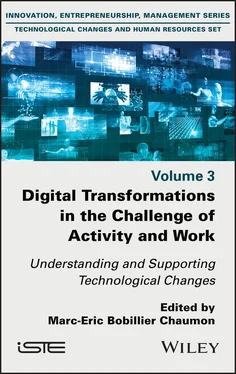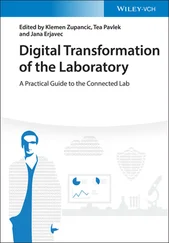Digital Transformations in the Challenge of Activity and Work
Здесь есть возможность читать онлайн «Digital Transformations in the Challenge of Activity and Work» — ознакомительный отрывок электронной книги совершенно бесплатно, а после прочтения отрывка купить полную версию. В некоторых случаях можно слушать аудио, скачать через торрент в формате fb2 и присутствует краткое содержание. Жанр: unrecognised, на английском языке. Описание произведения, (предисловие) а так же отзывы посетителей доступны на портале библиотеки ЛибКат.
- Название:Digital Transformations in the Challenge of Activity and Work
- Автор:
- Жанр:
- Год:неизвестен
- ISBN:нет данных
- Рейтинг книги:4 / 5. Голосов: 1
-
Избранное:Добавить в избранное
- Отзывы:
-
Ваша оценка:
- 80
- 1
- 2
- 3
- 4
- 5
Digital Transformations in the Challenge of Activity and Work: краткое содержание, описание и аннотация
Предлагаем к чтению аннотацию, описание, краткое содержание или предисловие (зависит от того, что написал сам автор книги «Digital Transformations in the Challenge of Activity and Work»). Если вы не нашли необходимую информацию о книге — напишите в комментариях, мы постараемся отыскать её.
Digital Transformations in the Challenge of Activity and Work — читать онлайн ознакомительный отрывок
Ниже представлен текст книги, разбитый по страницам. Система сохранения места последней прочитанной страницы, позволяет с удобством читать онлайн бесплатно книгу «Digital Transformations in the Challenge of Activity and Work», без необходимости каждый раз заново искать на чём Вы остановились. Поставьте закладку, и сможете в любой момент перейти на страницу, на которой закончили чтение.
Интервал:
Закладка:
1.3.3. Increase in virtual teams vs isolation of employees
A third contradiction concerns the increase in virtual teams/collaborations, which can paradoxically be accompanied by the isolation of employees. This also reflects the opposition between “ collective work ” and “ a work collective ” (or teamwork) (Caroly and Clot 2004).
Collaborative work platforms and corporate digital social networks are thus being deployed, which ultimately aim more at prescribing collaborations between employees than at supporting existing cooperations. Without this bias, the company seeks to optimize collective intelligence, transversality and decompartmentalization between departments and teams, which are the new spearheads of matrix and agile organizations (Barville et al . 2018; see Chapter 2in this book).
The aim of these systems is to order or even impose special forms of cooperation between employees in order to increase exchanges and collaborative work remotely (Crouzat and Bobillier Chaumon 2017; see Chapter 14in this book). However, by seeking to organize collective work – at the expense of collective work – these technical environments create artificial collectives (Crapeau 2001) composed of individuals opportunely linked according to the needs of the organization and projects. However, this does not in any way promote the feeling of belonging to a professional community, to a work collective, or teamwork.
It should be remembered that this working group is the indispensable framework for regulating work constraints. The collective refers to a community of actions and thoughts, essential in the relationship between the individual and the work situation (Lhuilier 2006). It creates a sense of belonging and identification with a professional community. The role of the collective is therefore essential, because it is both a resource and a support (psychological, cognitive, social, professional) for individual action and a “social shock absorber” for organizational pressures. The absence or decline of these groups is partly responsible for the suffering of employees who are then unable to manage the various risks of the activity and to cope with the demands of the organization.
With these collaborative environments, if people feel like they are working virtually together, they do so by being more alone in front of their computers. This contributes to creating what Clot (2010) calls a collection of individuals, that is, an arrangement of interchangeable skills, linked together by fake relationships, and where individuals are exposed to isolation: they do not know who to rely on, who to turn to in case of a problem, who to open up to in case of a hard blow. This isolation can be compounded by a feeling of loneliness when one feels excluded or even banished from the working group to which one belongs. One feels alone among others in a way. Marc and Ladreyt (2019) speak of distressing loneliness to describe “a subjective experience suffering from delirium associated with a perceived lack of social support. The subject faces a solitary and constrained face-to-face encounter with himself/herself. This form of loneliness is pathogenic. It is an experience conducive to restlessness” (p. 262), which is accompanied by a withdrawal into oneself, a voluntary abandonment of all ties with others. The result is a double exclusion “of oneself among others and of others in oneself”.
This distressing loneliness can appear when the organization “corrupts” the use of certain technological artifacts by putting employees in competition with each other, which can be harmful to existing collectives. “Surviving together” then gives way to “every man for himself”. Indeed, as we have seen previously, certain tools seek to trace the activity and to report on the task performed using various numerical indicators. However, these indicators (often partial because they are based on the performance performed) prove to be inappropriate and insufficient to testify to the specificities and requirements of the real activity: namely, all the trials, errors, bewilderment, etc. necessary to complete the work. Management will, however, use these data to encourage emulation between employees. However, these individualized evaluations push individuals to judge, compare, confront and finally come head to head with each other between competitors (and no longer colleagues) at the risk of jeopardizing the relationships of mutual aid and trust, which are necessary for social cohesion in the activity. The other is then seen as an adversary that I must protect myself from and keep at a distance. This competition with others can also be doubled with competition with oneself when the individual seeks to maintain a level of excellence in the activity (de Gaulejeac and Hanique 2018), which in the end turns out to be very deleterious, even deadly.
1.3.4. Nomadism vs a sedentary lifestyle at work
The office is no longer the major or exclusive determinant of work. Thanks to digital environments (permanent office, “office in the pocket”), it has been exported, largely outside the walls of the company (work without borders) and has freed itself from the temporal, spatial and organizational barriers of the company. While some employees carry out an activity from their home (home office, teleworking; Vayre 2019), others tend to engage in a nomadic type of activity by alternating between workplaces (customer base, hotel, transport, third party places such as coworking areas, etc.) and different schedules (part of the work being carried out in “concealed” time, i.e. on transport or during other waiting times) (Vacherand-Revel 2017; Lutumba et al. 2020). These employees thus find themselves more or less voluntarily immersed in environments that each have their own requirements and that demand particular practices and uses. Thus, depending on the digital demands, employees must improvise their professional activities in situations that they do not always control, and which do not necessarily lend themselves to the task to be carried out with the technical system (Bonneau and Enel 2018). The different roles and work contexts then interpenetrate each other and this can create conflict (Marks and MacDermid 1996). Concretely, the individual may be psychologically and/or behaviorally engaged in one area/situation, but physically and temporally present in another area. Being able to carry out an activity in an inappropriate and potentially disruptive environment requires increased attention and focus (Popma 2013).
While nomadism is one of the characteristics of modern work, which technology has undoubtedly contributed to and has accentuated and accelerated it, sedentary life is paradoxically another facet of these digitized situations.
Indeed, there are still a number of economic sectors in which employees remain glued to their computers to carry out almost all the tasks inherent in their professional activity: from mediated interactions between colleagues (remote offices, being away from the workplace) to remote meetings, from information management (research, archiving) to training (e-learning) and even for moments of relaxation and social breaks (surfing on the web and social networks) (Debrosses 2019). It should be noted that this sedentary lifestyle has a major health cost since, according to epidemiological studies, it causes various major organic and physical disorders and causes mortality greater than that caused by cigarette consumption (Wen and Wu 2012). A study by the American Cancer Society indicated that the mortality rate of a person sitting more than six hours a day is 20% higher than that of a person sitting only three hours a day (Patel et al . 2010).
1.3.5. Detachment from activity vs proximity of work
Интервал:
Закладка:
Похожие книги на «Digital Transformations in the Challenge of Activity and Work»
Представляем Вашему вниманию похожие книги на «Digital Transformations in the Challenge of Activity and Work» списком для выбора. Мы отобрали схожую по названию и смыслу литературу в надежде предоставить читателям больше вариантов отыскать новые, интересные, ещё непрочитанные произведения.
Обсуждение, отзывы о книге «Digital Transformations in the Challenge of Activity and Work» и просто собственные мнения читателей. Оставьте ваши комментарии, напишите, что Вы думаете о произведении, его смысле или главных героях. Укажите что конкретно понравилось, а что нет, и почему Вы так считаете.












